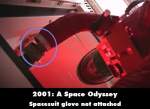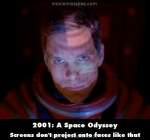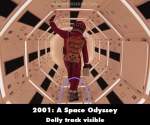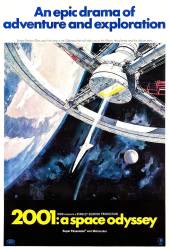
Continuity mistake: After David Bowman returns to Discovery One, HAL disables all life support systems in order to protect "himself" from being shut off. But Bowman successfully enters the ship, grab a helmet and goes to the Logic Center, to shut down HAL by disabling the Memory Banks. But, when opening the hatch to enter the Memory Bank, you can see his naked left wrist, for the spacesuit and the glove are disconnected. (01:51:10)

Deliberate mistake: When Dave is in the pod arguing with Hal to let him back in, various patterns of light are projected on Dave's face presumably from the video screens that say NAV and COM and such. Light on such a screen would diffuse and not project like this. It is likely those screens had rear projection and they merely removed the screens for this effect.

Visible crew/equipment: When David walks with the case in the hand inside the Discovery One, you can see the dolly track below at David's feet blending in the structure. (01:12:12)
Continuity mistake: When we see the outside of the cave where the apes are sleeping for the first time it's at sunset. We can see the sun and cloud behind the cave as if it is just sitting in a rock face with nothing behind it, but in the next shot when it's daytime suddenly there is a background of rocks and mountains behind the cave.
Deliberate mistake: On the space station after Dr. Floyd has just gotten off the elevator and is talking to a receptionist, the moon image in the window is revolving with the exact appearance it had when Floyd was in the telephone booth when the camera angle is perpendicular to the window and presumably parallel to the station's rotational axis. In the receptionist scene, the view of the window is at an angle yet the rotating moon image is the same. This would require a different axis of rotation for the space staton - one in which the station would be wobbling.
Revealing mistake: When Dave Bowman attempts to re-enter Discovery One via the emergency airlock after blowing the explosive bolts on the pod door, where does said pod door go? And also, because of Newton's law of motion, the sudden rush of cabin air during decompression inside said pod after the bolts had blown the door off would have resulted in the pod being pushed in the opposite direction (in effect, that rapid escaping air would have acted like a rocket motor, propelling the pod like a cannonball from a gun!).
Suggested correction: Did you watch the film? The pod bay door doesn't come into it. Bowman enters via the emergency entrance, not a pod bay. The door of the pod and the door of the emergency exit slide sideways into cavities that are there for that purpose - hinged doors don't make any sense in a cramped spacecraft. We see the emergency entrance doorway slide back into position when Bowman activates it.
I think you confused the pod bay door with the door on the pod itself. In the explosive bolt sequence, the pod door does disappear. There is an expanding cloud from the pod door, but no flying door or evidence of it in the emergency airlock. Just an open hole in the pod.
In the scene just before HAL reads the astronauts' lips in the pod, we see that the pod door does slide sideways into the pod hull. The explosive bolts, marked by small red patches, are located in a pattern all around the edge of the door. This indicates that the explosive bolts would blow that section of the door outward rather than sideways into the hull storage pocket.
Bowman programmes the bolts on one side of the door only to detonate, blowing it sideways.
Sure, that might work, but how about this? Bowman knows that the door is constructed of a special composite material that instantly vaporises if it is compressed in just the right way. So, he reprograms the charges to set up a harmonic series of shock wave fronts that destabilises the composite of the door structure, tuning it into the large cloud of smoke we see in the scene.





